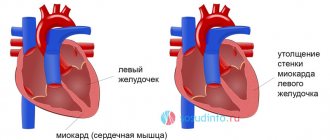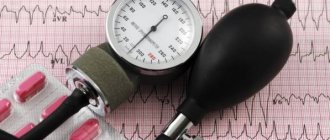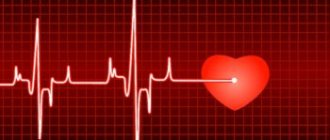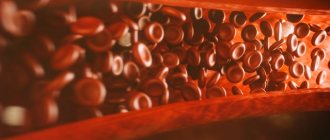The pulse of athletes at rest can be 40-50 beats per minute, since a trained heart pumps a larger volume of blood with each contraction. For people who do without physical education, the indicator is 60-85.
But even among athletes, heart rate norms differ depending on the type of activity: the harder they are for the organ, the lower it is. And yet, a pulse up to 40 is bradycardia. With this figure, you should consult a doctor to identify the cause of the symptom. Sometimes, to eliminate it, it is enough to moderate or adjust the load more correctly; in other cases, medications or a pacemaker are needed.
Normal resting heart rate in athletes
Athletes' resting heart rate is less than 60 beats per minute - usually 40-50. Although for people far from sports, the norm is 60-85, which is determined by age, individual characteristics of the body, gender, and time of day at which the measurement was taken. During sleep, the indicator is lower; when awake, it increases.
The number of heartbeats up to 60 in an ordinary person is called bradycardia, over 90 - tachycardia. Both conditions require study and identification of causes, as they cause discomfort and can be symptoms of diseases. But a low heart rate for an untrained person, 40-50 beats per minute, is the norm for athletes. It is explained by the fact that:
- Exercises train the myocardium in the same way as the muscles of the body. In some cases it increases in size. And the heart does not need to beat many times to provide tissues and organs with oxygen. It pumps enough blood even at a slow pace.
- The heart muscle adapts to such work at rest due to regular high loads. Athletes' heart rate during training or competition can reach 260 beats per minute, so outside of training the cardiovascular system saves resources.
The indicator also depends on the type of sport. The higher the intensity and duration of exercise, the stronger the heart “thrashes”, pumping a larger volume of blood. And at rest it will beat much slower. For example, the heart rate of athletes specializing in long distance distances, football players, swimmers, cyclists, and skiers is noted to be at the lower limit of what is permissible.
These sports involve aerobic exercise, that is, training the heart. Weightlifters, discus throwers, and wrestlers work more actively in other muscles. And the heart is not as trained, so their resting heart rate will be closer to 50 beats per minute.
Is there 40 beats per minute?
A pulse of 40 for an athlete when not moving is also the norm, as long as his/her well-being does not suffer. This indicator is noted when:
- the person has been practicing for a long time and regularly;
- it tolerates the load well;
- The training system is built correctly and does not interfere with heart function.
Typically, a resting heart rate of 40 beats per minute is recorded in men; in women, the heart rate is slightly higher - by 5-10 units.
Maximum allowable value
The heart rate outside of movement, even for a trained person, should not be less than 40 beats per minute, although during sleep it can drop to 35. But the second number is rather an exception, especially if observed during wakefulness.
A reduced rate may be due to the individuality of the body and requires close attention to health. It cannot be ruled out that it is a manifestation of problems that are still masked.
The minimum resting heart rate can be achieved at 200-220 beats per minute during exercise. This indicator occurs among professional athletes. But for an ordinary person, such a load can cause a heart attack. Therefore, you should not strive for such numbers; it is enough to bring your heart rate to 180 beats per minute during training.
Or calculate the indicator more accurately using the formula for women:
(209 – age)x0.7.
For the stronger sex it is different:
(214 – age)x0.8.
Normal heart rate for an average person
In a healthy adult at rest, the normal heart rate ranges from 60 to 80 beats per minute. The pulse of professional athletes should be the same during breaks between physical activity. Its indicators increase only during sports.
The frequency depends on the time of day and the position at which it is measured. In a lying position, the heart rate is usually lower than in a sitting or standing position. To notice some deviations from the norm, it is worth measuring the pulse in one position and at a certain, identical time for several days.
Average heart rate depending on a person’s age:
- newborn children – 140 beats/min.;
- children under 2 years old – 100 beats/min;
- teenagers (up to 14 years old) - 80 beats/min.;
- women – 60–80 beats/min;
- men – 65–90 beats/min;
- elderly people – 65 beats/min.
Why is the heart rate of athletes different from that of an untrained person?
Athletes have a lower heart rate than an untrained person for several reasons:
- Exercise stabilizes and improves heart function. With each contraction, it pushes out a larger volume of blood than occurs in the body of a person who prefers a sedentary lifestyle.
- The athlete’s heart itself is better supplied with oxygen. The increased need for it due to exercise leads to the formation of new capillaries. And this makes frequent contractions of the heart muscle unnecessary to saturate the body with the substance.
- Athletes' vessels have more elastic walls and unclogged lumens. This also facilitates the work of the myocardium when not in motion. There is no need to contract frequently to improve blood circulation, it is already optimal.
- In athletes, blood pressure decreases, which is also due to the condition of the capillaries and heart. And increased blood pressure forces the organ to work more actively, because one of the factors of its growth is oxygen deficiency caused by poor blood supply.
As a result of all the changes that have occurred in the athlete’s body, his blood circulation is sufficient and stable, but the heart at the same time saves energy.
Description of sports heart
Bradycardia in adolescent and adult athletes can be physiological or pathological. The first form is often found in healthy people and those involved in sports activities. According to statistics, about 25% of trained men experience a similar phenomenon. In medicine, pharmacological bradycardia is also distinguished. The reason for its development lies in the use of certain medications.
As for pathological bradycardia, it can occur in acute or chronic form. In addition, it is divided into extracardinal and intracardinal. In the first case, we are talking about disruption of the functioning of individual organs that can have an indirect effect on the activity of the heart muscle. The intracardial type is said to occur when cardiac pathology occurs.
The body of a healthy person quickly adapts to physical activity. When he constantly has to train, the blood supply and energy metabolism changes. Such transformations make it possible to maintain good performance under increased loads.
During training, the heart can expand, which is myocardial hypertrophy. Such changes are usually reversible, so after rest the rhythm is completely restored.
Depending on the type of activity, athletes' hearts differ in size. The largest is found among representatives of high-speed disciplines (cyclists, swimmers, skiers, runners). The volume of the heart muscle is somewhat smaller in wrestlers, football players, and hockey players. The hearts of athletes who lift weights or are simply involved in fitness usually do not undergo changes.
With adequate loads in the gym, the main organ of the circulatory system ensures the body's endurance and normal performance. In a calm state, the heart muscle uses resources sparingly and the heart rate is within 60 beats per minute. If a lower heart rate is observed in athletes, this indicates bradycardia.
Many professional athletes are at risk of dying young. The reason for this outcome may be pathological processes occurring in the heart muscle due to power loads. In medical practice, this phenomenon is called “athletic heart”.
In people who engage in weightlifting, blood vessels are compressed by tense muscles during training. In this case, the vast majority of exercises are performed in combination with inhalation and a pause in breathing. This does not have a very good effect on pulmonary circulation. In order to cope with the resistance of the vessels and pump blood into them, the heart begins to work more intensely. Due to this, it increases in volume.
The situation is aggravated by excessive stress associated with sports, in combination with infectious chronic diseases, which can lead to changes in the structure of the myocardium. Against the background of certain pathologies, the heart expands, and its volume sometimes reaches 1500 cm³, which reduces the performance of the organ.
Dead muscle fibers become covered with scars. When there are more altered areas, the tissue begins to contract poorly and loses its ability to conduct impulses. This causes the heart to work erratically and arrhythmia occurs. Failures in the circulatory system lead to loss of ability to work. In this case, the athlete is forced to step away from sports and adhere to a sedentary lifestyle, unable to perform even small physical activities.
Heart rhythm disturbances rarely become the reason for the release of young people from military service. This condition usually does not require serious treatment and does not affect a person's physical ability. But if the problem becomes truly alarming, everything possible must be done to prevent the worst from happening.
Moderate bradycardia is not a reason to exempt a conscript from the army. A severe degree, which is characterized by a frequency of less than 30 beats, entails oxygen starvation of the organs. This form of pathology requires medical intervention. The severe course of such bradycardia can result in the appearance of heart failure, when the patient can no longer do without surgery to install a pacemaker.
| Functional class (FC) | Degree of exercise tolerance |
| 1 | Power loads do not cause discomfort and do not cause fatigue. |
| 2 | Physical activity is accompanied by fatigue, shortness of breath, and weakness. |
| 3 | Even reduced physical activity causes fatigue and shortness of breath. |
| 4 | Signs of heart failure are observed in a calm state. |
If we are talking about the first FC, the conscript can serve in the army. During the second FC, the young man is enlisted in the reserve and assigned category “B”. When the pathology occurs with pronounced signs of heart failure, the young man is given a military ID, where category “D” is entered. This completely exempts the conscript from military service.
When low heart rate is a symptom of disease
A low heart rate in people actively involved in sports may be a sign of malaise if, outside of movement, the following are present:
- prostration;
- low pressure;
- dizziness;
- feeling of lack of air;
- pain and feeling of stiffness behind the sternum;
- anxiety;
- inability to concentrate;
- headache;
- vision problems;
- panic attacks.
If at least some of the listed signs occur, it is necessary to be examined. It is possible that sport led to the development of bradycardia. This is a slow heartbeat, in which the nutrition of the organ is disrupted, which means the supply of oxygen to the tissues. Bradycardia is not a disease, but a symptom that can be present in many pathologies, not only cardiovascular ones.
The problem requires special attention when it comes to teenagers who are seriously interested in sports. Their cardiovascular system often does not keep pace with the growth of other tissues and organs. As a result, blood circulation and nutrition of the myocardium are disrupted, which can lead to serious illness and the need to completely stop training.
Why do professional athletes often have bradycardia?
A low, regular heart rate in athletes is called "athlete's heart syndrome."
It is often recorded in professional athletes, as well as in people who engage in sports for a long time (more than an hour a day). This is how the body adapts to stress. Despite its “physiological” nature, this condition can mask serious health problems. In adolescent athletes, bradycardia is often associated with changes in the cardiovascular system and also requires monitoring.
Most often, bradyarrhythmia is a consequence of active (more than 5 hours per week) aerobic exercise; less often it occurs when performing static exercises, for example, when lifting weights. During intense, long-term exercise, the heart pumps more blood to meet the increased oxygen demands of skeletal muscles. The chambers stretch, the wall increases in size. As a result, cardiomegaly (enlargement of the heart) and, in particular, left ventricular hypertrophy develop.
Methods for diagnosing the condition
You should first address the problem to a general practitioner, who will refer you to a cardiologist. To identify bradycardia and its cause:
- interview the patient to find out the details of his condition, under what circumstances it worsens or improves, what exactly worries him;
- prescribe blood and urine tests to detect or exclude an inflammatory process, determine the amount of substances that make up biological fluids;
- conduct an examination and measure the pulse to determine its fullness, frequency, and preliminary assess the condition of the heart and blood vessels;
- they do an ECG, which makes it possible to identify the functionality of the “human engine”, the electrical activity of its cells, and rhythm characteristics;
- carry out a Holter study, which reveals the peculiarities of the organ’s functioning under different types of load experienced during the day;
- perform an ultrasound of the heart to identify its size, integrity, structure and volume of components (chambers, walls, coronary vessels, pericardium, etc.), detect murmurs, infectious lesions;
- a stress load test is prescribed, in which it becomes possible to assess organ function during different types of physical activity (walking, running, cycling, etc.).
Pulse zone
The number of heart contractions per minute is called the pulse.
Experts determine pulse zones from a state of rest to the maximum load of the body. When playing sports, zone information is useful. With a heart rate in one zone, a person loses weight, in another he increases endurance or may have a heart attack. The boundaries of the zones are determined by special laboratory tests that athletes undergo, but approximate indicators can also be calculated at home. The maximum permissible heart rate is calculated using the formula Pmax = 220 – age. Depending on the larger indicator, the remaining zones are calculated as follows:
- In the range of 50-60% of the highest value. Easy running. Allows you to train your heart and blood vessels. Breathing is calm, the person can speak and sing.
- 60-70% of fat deposits are burned. Easy running. A person can talk to a running partner.
- 70-80% of the body develops endurance. It turns out to talk in fragments. Breathing is rapid.
- 80-90% strength and speed endurance. For an unprepared body, this zone can become critical. The pulse of a normal person, physical activity at the limit. Heavy breathing, difficulty speaking, redness of the face.
- 90-100% speed endurance for those who play sports constantly. The limit to which a trained person’s body can cope with stress.
Treatment for bradycardia
Therapy for bradycardia, which is not bothersome by other manifestations, consists of correcting physical activity. It could be:
- Its reduction. You will have to reduce activity if it turns out that the heart cannot cope with the work due to the high intensity of exercise. This may be necessary with age, or when pathologies are discovered that do not allow the presence of professional sports in life.
- Changing the training system. They should begin with a gradual increase in load, that is, with warm-up exercises that prepare the body for more active work. This way, it is possible to relieve the heart of stress, and as a result it functions more stably.
To eliminate the symptom, it is important to stop smoking and drinking too much alcohol. Both bad habits also put a strain on the heart and interfere with the functioning of blood vessels.
Sometimes it is necessary to use drugs from the groups of sympathomimetics and anticholinergic blockers, which are prescribed by a doctor. In case of severe bradycardia caused by structural changes in the heart, installation of a pacemaker is indicated.
Cause of increased heart rate
When the pulse increases, the following symptoms may appear: confusion, lightheadedness, dizziness, nausea, vomiting, blurred vision, increased sweating, tremor. In this case, the help of a doctor is required. There may be several reasons for this condition:
Such symptoms should not appear even after training. Within 20 minutes, the heart rate should recover after physical activity. The norm is considered to be its leveling within 40 minutes.
What are the dangers of bradycardia?
Even athletic people with a heart rate of 40 beats per minute should undergo regular preventive examinations to study the condition of their heart. Otherwise, asymptomatic bradycardia can lead to serious consequences:
- cerebrovascular accident;
- the occurrence of chronic heart failure;
- development of ischemic heart disease;
- myocardial infarction;
- cardiomyopathy;
- insufficiency of heart valves and the development of other defects requiring surgical intervention.
In addition, the syndrome increases the likelihood of sudden cardiac arrest.
A more moderate heart rate for those involved in sports is normal. But it should not fall below a certain value and be accompanied by a deterioration in well-being. If this happens, you need at least an examination by a doctor and a change in your training system.
Treatment
To effectively treat increased heart rate after exercise, it is first necessary to determine the cause of the disease. The way of life is changing. A clear schedule of work, rest and sleep is determined. Sleep should last at least 8 hours. If there are pathologies, physical training should begin with minimal loads (if the doctor has cleared you for exercise). Avoid bad habits and take regular walks in the fresh air. It is necessary to drink plenty of water, remain calm, and avoid nervous tension. It is recommended to pay attention to breathing exercises, which helps strengthen the heart muscle. If necessary, the doctor can prescribe heart vitamins CardioActiv and Riboxin. In case of severe pathology, special therapy with medications and surgical interventions is indicated.
During physical training, you need to monitor your well-being. If heaviness, heart pain, shortness of breath, or rapid pulse appear, you should stop exercising immediately. Restore your breathing and contact a specialist. It should be remembered that an increased heart rate is not always the norm.
Heart rate norms during sports
By contracting, the myocardium pushes blood into the vascular system and imparts some vibration to the arterial walls. It is these tremors, which can be felt in certain places, that are called the pulse.
A healthy person at rest produces from sixty to eighty, and in some cases ninety, pulse beats per minute.
Moreover, it is quite deservedly considered that a person feels better with values not higher than seventy-five.
Pulse frequency depends on many different factors, which include external conditions and various pathologies. We will not touch on the topic of diseases, one of the symptoms of which is a rapid pulse, but will talk about the reasons that even an absolutely healthy person faces.
First of all, it is necessary to take into account age, on which the indicator directly depends.
In a newborn baby, the normal heart rate is 140, by the age of five the value decreases to 85 - 120, and by the age of fifteen the child’s value is compared with that of an adult.
In adolescence, the pulse may also increase due to sudden hormonal changes in the body. After fifty years, the value of the parameter begins to increase again.
In addition, men have lower average pulse rates than the fairer sex. This is due to the characteristics of female physiology, higher excitability of the nervous system and some other factors. As a rule, this pattern is also observed in the case of physical activity.
What happens under load
The increase in heart rate during exercise is explained by the increasing load on the heart, which contracts more often, resulting in an increase in the number of pulse beats.
It becomes clear that in the case of an untrained and unprepared body for such stress, minimal effort will cause a pronounced increase in heart rate.
In experienced athletes, the frequency of myocardial contractions and pulsation increases slightly even during prolonged intense exercise.
A rapid pulse in people suffering from cardiac pathologies is explained by the fact that the heart is forced to contract more often to pump a sufficient amount of blood throughout the body. At the same time, bradycardia, characteristic of professional athletes, is due to the ability of the myocardium to push out the required volume of blood in fewer contractions.
If a person does not suffer from diseases of the heart and blood vessels, or pathologies of other internal organs, he is allowed to play sports. Despite the increase in heart rate during training, over time it is possible to achieve a decrease in its frequency and easier exercise. People with cardiac pathologies are only recommended for physical therapy aimed at normalizing the functioning of the heart.
How to calculate your heart rate during exercise
In a calm state, it is better to determine the pulse value in the morning soon after waking up. The maximum heart rate during physical training (MP) can be calculated using the formula: 220 – the person’s age. However, this is the simplest option. Some sports doctors claim that there is a difference in this indicator between men and women, and propose to determine it using the formulas:
- MP for men - 214 - (age × 0.9).
- MP for women - 209 - (age × 0.8).
MP values for representatives of different genders and age groups are given in the table:
| Age | MP for women | MP for men |
| 20 | 191 | 198 |
| 25 | 186-187 | 194 |
| 30 | 182 | 190 |
| 35 | 177-178 | 186 |
| 40 | 173 | 182 |
| 45 | 168-169 | 178 |
| 50 | 164 | 174 |
| 55 | 159-160 | 170 |
| 60 | 155 | 166 |
| 65 | 150-151 | 162 |
| 70 | 146 | 158 |
| 75 | 141-142 | 152 |
What are pulse zones and how to determine them
To select the optimal training intensity, it is necessary to determine not only the MP, but also the pulse zone suitable for this person, of which there are five:
- Initial - suitable for beginners, who are given the most insignificant, gradually increasing loads during their first training sessions. In this case, the pulse frequency is no more than 50–60% of the MP. Over time, a person gets used to such loads, performs exercises with ease and does not feel an increase in heart rate.
- Fitness - indicated for those who want to lose weight, since it is at its characteristic pulse rate, which is 60-70% of MP, that fats are broken down, and the functioning of the heart, blood vessels and respiratory organs is normalized.
- Aerobic - during training, the pulse fluctuates between 70 - 80% of MP, lipid molecules are practically not burned, and instead the breakdown of carbohydrates is used to obtain energy. Exercises in this mode help improve the condition of the vascular system, strengthen the heart, increase the number of blood vessels, and increase the strength and elasticity of their walls.
- Anaerobic - the heart rate (HR) reaches 90% of MP, the loads are high, the previous level is maintained and the cardiovascular and respiratory systems are further strengthened. Lipids completely stop breaking down, energy is obtained by burning glucose.
- Red line - heart rate is 100% MP, recommended exclusively for professional athletes or with great frequency.
Heart rate values for different zones are shown in the table:
| Heart rate during exercise, % of MP | Zone name | Zone description | Age (years) | Pulse (women) | Pulse (men) |
| 50 — 60 | Heart health or | Used when charging or lightly warming up | 20 | 95-114 | 99-119 |
| 40 | 86-104 | 91-109 | |||
| 55 | 80-96 | 85-102 | |||
| 70 | 73-88 | 79-95 | |||
| 60 — 70 | Fitness or zone | The overall endurance of the body increases, | 20 | 115-134 | 119-139 |
| 40 | 104-121 | 109-127 | |||
| 55 | 96-112 | 102-119 | |||
| 70 | 88-102 | 95-111 | |||
| 70 — 80 | Aerobic or zone | The volumetric beat of the heart increases, | 20 | 134-153 | 139-158 |
| 40 | 121-138 | 127-146 | |||
| 55 | 112-128 | 119-136 | |||
| 70 | 102-117 | 11-126 | |||
| 80 — 90 | Anaerobic or zone | Increased muscle mass and strength | 20 | 153-172 | 158-178 |
| 40 | 138-156 | 146-164 | |||
| 55 | 128-144 | 136-153 | |||
| 70 | 117-131 | 126-142 | |||
| 90 — 100 | Red line or zone | Maximum load intensity used | 20 | 172-191 | 178-198 |
| 40 | 156-173 | 164-182 | |||
| 55 | 144-160 | 153-170 | |||
| 70 | 131-146 | 142-158 |
However, it must be taken into account that these values are valid for people with sufficient physical fitness and activity. Physical inactivity, which affects a huge number of people of different ages and occupations today, determines the achievement of MP with little effort.
Physical activity causes a greater increase in heart rate in a child than in an adult. This is explained by the fact that in childhood there is rapid development and growth of the body, and the heart is smaller than in adults.
What heart rate is indicated for cardio training?
First of all, let's clarify what cardio training is? This is an improvement in the condition of not only muscles, but also the heart, blood vessels, respiratory system, stimulation of metabolic processes leading to fat burning and, accordingly, a decrease in body weight. This is done mainly by running, cycling, swimming, dancing, aerobics and other physical exercises aimed at saturating the body with oxygen and improving breathing.
Cardio is especially widely used for weight loss. In this case, it is especially important to know what heart rate during cardio training promotes maximum lipid breakdown. You should determine your heart rate during training and remember that the greatest amount of fat is burned when the heart rate is between 60 and 70% of MP, i.e. in the pulse zone, which is called “fitness”.
Source: https://lechimsosudy.com/normy-pulsa-vo-vremya-zanyatij-sportom/
Change in heart rate during exercise
Under the influence of training, the athlete’s performance increases, which is reflected in the functional indicators of the body’s fitness.
The most important change in regular endurance training is shifting the deflection point towards a higher heart rate.
For example, in an untrained person, the heart rate is 130 beats/min. After a period of endurance training, his heart rate shifts from 130 to 180 beats/min (see Graph 15 above). This means that his aerobic capacity has increased and he can now perform prolonged exercise at a higher heart rate.
The relationship between heart rate and lactate levels varies among individuals and can change within the same individual as their functional status changes.
Graph 17 For an untrained person, the heart rate is 130 beats/min, and for a trained person it is 180 beats/min. An untrained person is able to perform work for a long time at a heart rate of 130 beats/min, and a trained person at a heart rate of 180 beats/min. This threshold is called the anaerobic threshold and corresponds to a lactic acid level of 4 mmol/l. A load exceeding the anaerobic threshold leads to a sharp increase in lactic acid in the body.
Increase in MIC
VO2 max (maximum oxygen consumption) is the greatest amount of oxygen that a person is able to consume during maximum power exercise. MIC is expressed in liters per minute (L/min). During exercise at the MIC level, the body's energy supply is carried out aerobically and anaerobically.
Since anaerobic energy supply is not unlimited, the load intensity at the MOC level cannot be maintained for a long time (no more than 5 minutes). For this reason, endurance training is performed at intensities below VO2 max. Under the influence of training, VO2 max can increase by 30%. Normally, there is a linear relationship between heart rate and oxygen consumption.
Table 2.4. The relationship between heart rate and oxygen consumption.
| % of HRmax | % of MPC |
| 50 | 30 |
| 60 | 44 |
| 70 | 58 |
| 80 | 72 |
| 90 | 86 |
| 100 | 100 |
Since maximum power load can only be maintained for 5 minutes, VO2 max is not a representative indicator of the functional capabilities of endurance athletes. The most appropriate criterion for assessing functional abilities in endurance athletes is the anaerobic, or lactate, threshold.
The anaerobic threshold corresponds to the maximum level of effort that an athlete can maintain for an extended period of time without accumulating lactic acid. The anaerobic threshold can be expressed as a percentage of VO2 max or HRmax.
Graph 18. The right vertical axis shows the shift in heart rate after the training period. Before the start of training, heart rate was 130 beats/min. After several months of training, heart rate increased to 180 beats/min. The left vertical axis shows the increase in VO2max, and especially the percentage of VO2max, or heart ratemax, at which work can be maintained for a long period of time.
When you exercise, your heart rate increases and your body requires additional energy. To obtain it, it is necessary to deliver oxygen to all tissues. This is achieved by increasing blood circulation, heart rate and blood pressure.
The heart rate usually increases during physical activity. But sometimes there are situations in which the heart rate becomes less frequent and bradycardia appears. The symptom occurs in athletes or people with a malfunction of the cardiovascular system.
An uneven pulse after exercise indicates sinus arrhythmia. The heartbeat is within normal limits or increased. This is not a pathology and usually does not require the abolition of physical activity.
Consequently, bradycardia is a common occurrence for athletes. The norm for sports fans is 50-60 beats/minute. People with a trained heart do not have fatigue, dizziness, heart pain and other symptoms of bradycardia.
Diagnostics
Signs of bradycardia in adolescents and adults are often detected during a medical examination. The patient may complain of a rare pulse, changes in blood pressure and respiratory arrhythmia. In this case, consultation with a cardiologist is required. To make a more accurate diagnosis, it will be necessary to undergo a number of examinations, namely:
- ECG. This diagnostic method allows you to identify the presence of atrioventicular or sinoatrial blockade and record irregularities in the heartbeat. Additionally, daily ECG monitoring may be prescribed.
- Load bicycle ergometry. This study tests the body's ability to withstand increased physical activity and determines the time spent on recovery.
- Ultrasound of the heart. It is carried out for organic bradycardia and allows you to determine the changes occurring in the work of the heart muscle and myocardium.
- CHPEFI. When Holter monitoring and ECG are unable to detect blockages, transesophageal electrophysiological examination is performed. Thus, it is possible to examine the conduction system and detect a functional or organic form of bradycardia.
How to measure pulse?
To measure your pulse at home, you need to find the points where it can be felt best. To do this, put your hand on the arteries:
- sleepy;
- temporal;
- ray;
- brachial;
- popliteal;
- femoral;
- brachial.
The most popular way to determine heart rate is to measure it on the radial artery, which is located in the wrist. To do this, you need to place three fingers on the radial artery, feel the pulsation and use a stopwatch to determine the number of beats per minute. For daily monitoring, measurements are made under equal conditions. To determine the normal heart rate during physical activity, measurements are taken at the end of the workout and after 20 minutes.











